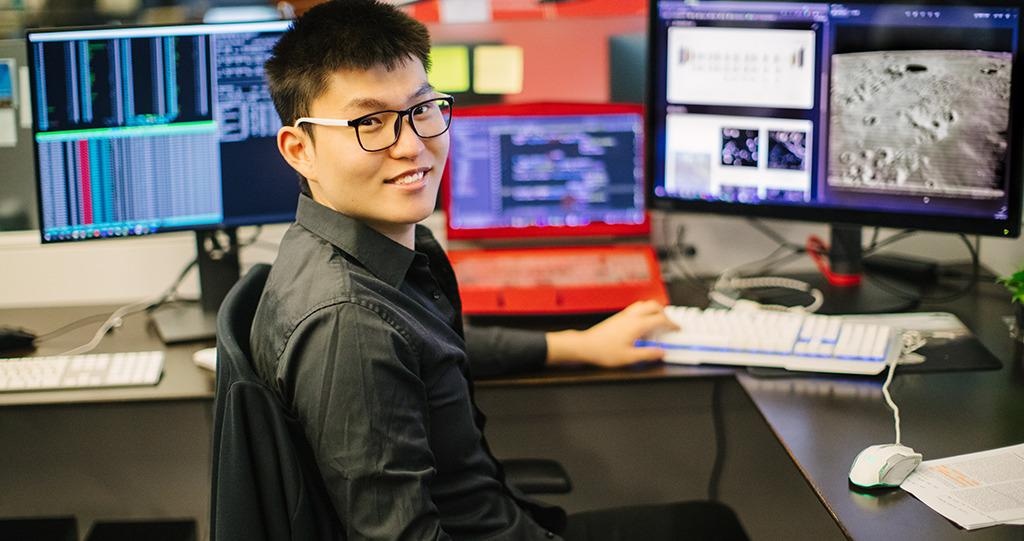A new technique of moon scanning could help automatically categorize the essential lunar features from telescopic images and can also remarkably enhance the efficiency of choosing sites for exploration.
 Siyuan Chen (pictured above) and Professor Xin Gao used machine learning and AI to identify promising lunar areas for the exploration of precious resources, such as uranium and helium-3. Image Credit: KAUST; Anastasia Serin.
Siyuan Chen (pictured above) and Professor Xin Gao used machine learning and AI to identify promising lunar areas for the exploration of precious resources, such as uranium and helium-3. Image Credit: KAUST; Anastasia Serin.
There is much more to choosing a landing or exploration site on the Moon than what is just observed. The lunar surface’s visible area is bigger compared to Russia and is pockmarked by thousands of craters and crisscrossed by canyon-like rilles.
The options for future landing and exploration sites might descend to the most potential locations for construction, minerals or possible energy resources. However, scanning the larger area by eyes, searching for features that measure a few hundred meters across is strenuous and not typically perfect. This makes it hard to select an ideal area for exploration.
At present, Siyuan Chen, Xin Gao and Shuyu Sun, together with their collaborators from The Chinese University of Hong Kong, have employed artificial intelligence (AI) and machine learning to automatically find potential lunar landing and exploration areas.
We are looking for lunar features like craters and rilles, which are thought to be hotspots for energy resources like uranium and helium-3—a promising resource for nuclear fusion. Both have been detected in Moon craters and could be useful resources for replenishing spacecraft fuel.
Siyuan Chen, Computational Bioscience Research Center, Computer, Electrical, and Mathematical Sciences and Engineering Division, King Abdullah University of Science and Technology
Machine learning is considered to be a highly effective method to train an AI model for identifying some features by itself. The initial issue that was experienced by Chen and his collaborators was the non-availability of a labeled dataset for rilles that could possibly be utilized to train their model.
We overcame this challenge by constructing our training dataset with annotations for both craters and rilles. To do this, we used an approach called transfer learning to pretrain our rille model on a surface crack dataset with some fine tuning using actual rille masks.
Siyuan Chen, Computational Bioscience Research Center, Computer, Electrical, and Mathematical Sciences and Engineering Division, King Abdullah University of Science and Technology
“Previous approaches require manual annotation for at least part of the input images —our approach does not require human intervention and so allowed us to construct a large high-quality dataset,” added Chen.
The next difficulty faced by the group was to develop a computational method that could be utilized to determine both rilles and craters simultaneously. This is a task that has not yet been performed.
This is a pixel-to-pixel problem for which we need to accurately mask the craters and rilles in a lunar image. solved this problem by constructing a deep learning framework called high-resolution-moon-net, which has two independent networks that share the same network architecture to identify craters and rilles simultaneously.
Siyuan Chen, Computational Bioscience Research Center, Computer, Electrical, and Mathematical Sciences and Engineering Division, King Abdullah University of Science and Technology
The method used by the researchers helped them achieve a high accuracy level of 83.7%, which is greater compared to the existing advanced methods of crater detection.
Training an AI eye on the Moon
KAUST scientists have developed a machine learning method to explore the surface of the moon. Video Credit: © 2021 KAUST; Anastasia Serin.
Journal Reference:
Chen, S., et al. (2021) Lunar features detection for energy discovery via deep learning. Applied Energy. doi.org/10.1016/j.apenergy.2021.117085.